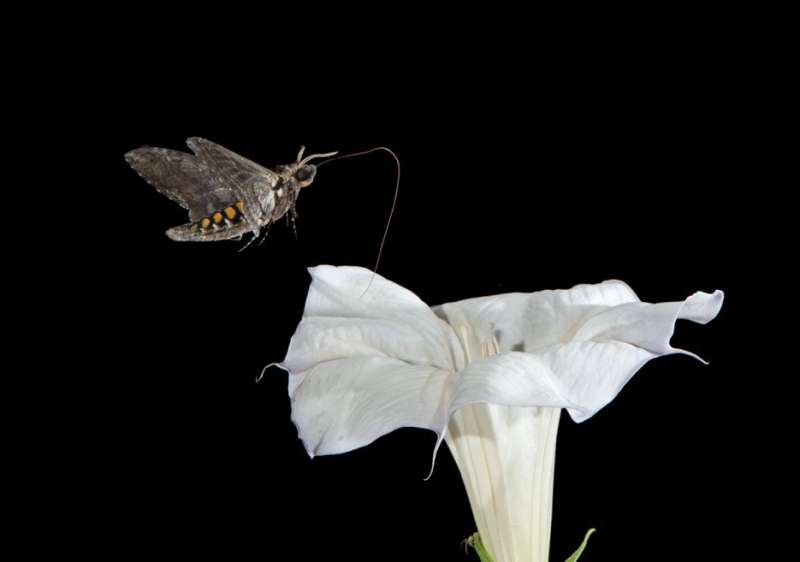February 17, 2017 report
Moths found to produce their own antioxidants from carbohydrates

(Phys.org)—A team of researchers with members from the University of Arizona and New Mexico State University has discovered how a species of moth is able to repair oxidative muscle damage without consuming antioxidants. In their paper published in the journal Science, the team describes their study of the hawkmoth and how they discovered an adaption that allowed it to remain free of muscle damage. Carlos Martinez del Rio and Michael Dillon with the University of Wyoming offer a Perspective piece on the work done by the team in the same journal issue and give some historical background to explain why some pollinators needed to develop an alternative means for protecting their muscles.
As Martinez del Rio and Dillon note, when muscles expend energy they create byproducts called reactive oxygen species, which are damaging to cells. Most animals prevent damage to muscle cells by consuming foods with antioxidants in them. But some creatures with muscles do not consume antioxidants and still manage to avoid muscle damage—hawkmoths, for example, live on a diet of nectar and nothing else, which means they never consume any antioxidants. Furthermore, they also use their muscles a lot—they furiously beat their wings to allow them to hover near a nectar producing plant while they take a quick sip. Until now, it was not known how the moths pulled off this trick.
To find out the researchers obtained a collection of hawkmoths and began feeding them nectar while also measuring them for muscle damage after they took short flights. They then compared those results with measurements taken from moths that were not given nectar—the control group. The researchers report that the moths that were fed nectar flew farther than the control group, yet had less oxidative damage—remarkably, they also had higher levels of antioxidants in their systems. The researchers continued their experiments by adding different carbon isotopes to the nectar they fed to the moths to allow for tracking how the nectar was metabolized. They found that the moths used what is known as the pentose phosphate pathway (a metabolic pathway that generates NADPH, pentose and ribose) to convert some of the carbohydrates (glucose) in their diet into antioxidants—they did not need to ingest antioxidants because they were generating their own.
Martinez del Rio and Dillon suggest that other insects and mammals likely use the same process and some may rely on a combination of ingestion and conversion to meet their antioxidant needs.
More information: E. Levin et al. Hawkmoths use nectar sugar to reduce oxidative damage from flight, Science (2017). DOI: 10.1126/science.aah4634
Abstract
Nectar-feeding animals have among the highest recorded metabolic rates. High aerobic performance is linked to oxidative damage in muscles. Antioxidants in nectar are scarce to nonexistent. We propose that nectarivores use nectar sugar to mitigate the oxidative damage caused by the muscular demands of flight. We found that sugar-fed moths had lower oxidative damage to their flight muscle membranes than unfed moths. Using respirometry coupled with δ13C analyses, we showed that moths generate antioxidant potential by shunting nectar glucose to the pentose phosphate pathway (PPP), resulting in a reduction in oxidative damage to the flight muscles. We suggest that nectar feeding, the use of PPP, and intense exercise are causally linked and have allowed the evolution of powerful fliers that feed on nectar.
Journal information: Science
© 2017 Phys.org




















